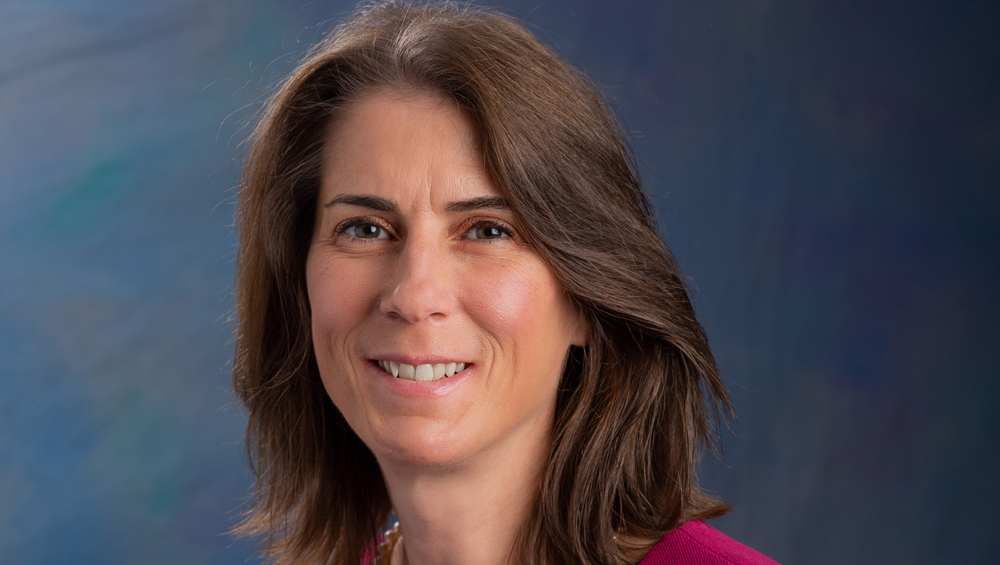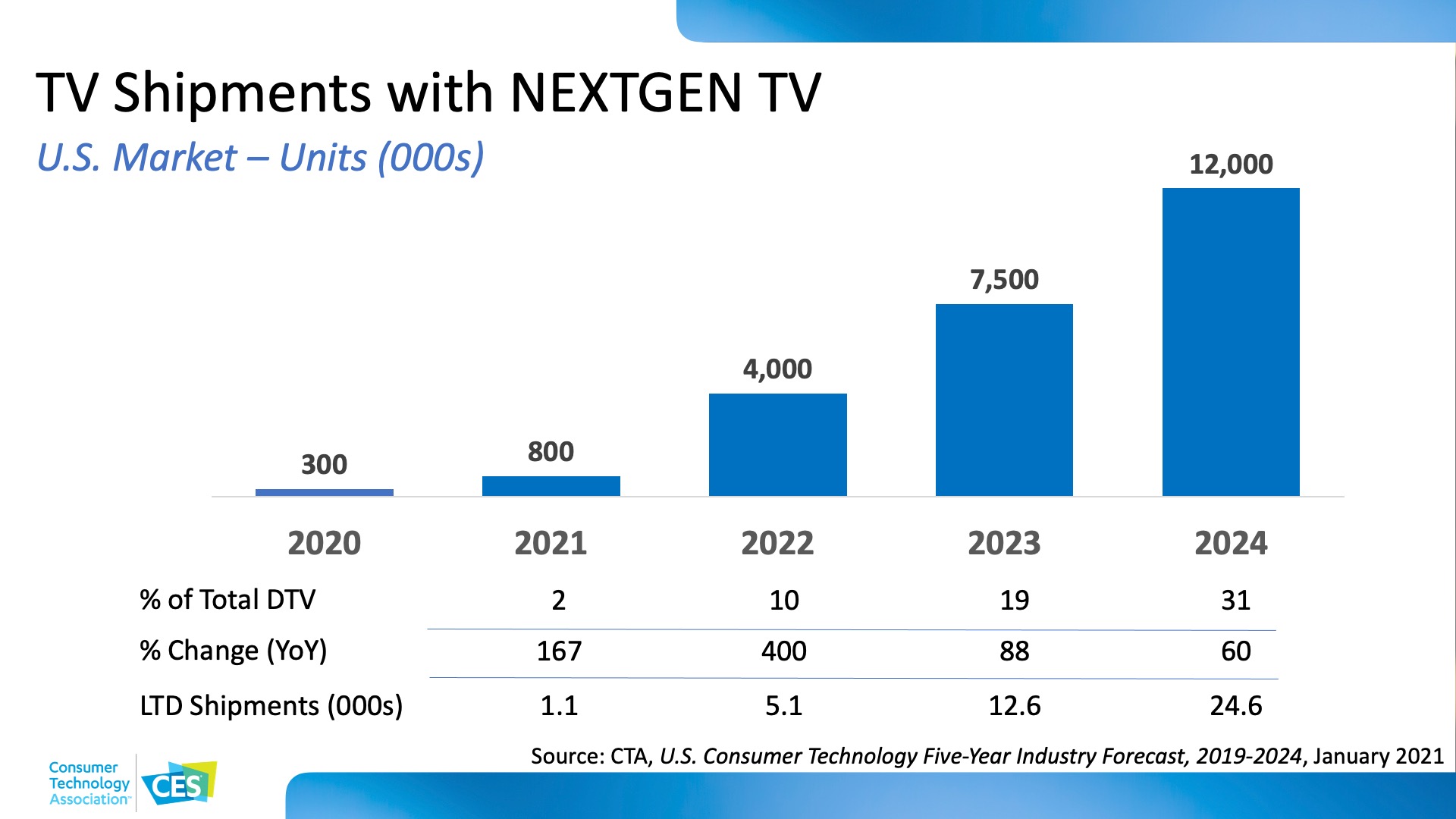
TVN Tech One-On-One | Assessing A Pivotal Year For NextGen TV

The ATSC 3.0 broadcast standard took a big leap forward at last year’s CES show in Las Vegas with the introduction of the first 3.0-capable TV sets. LG, Samsung and Sony pledged to roll out a total of 20 of the new “NextGen TV” models in 2020, while broadcasters aimed to launch 3.0 signals in the Top 40 markets, and over 60 overall, by year-end.
Like many things in 2020, not all of those plans came to fruition, though set-makers did follow through on their “20 in 2020” promise and shipped 300,000 NextGen TV sets last year, according to the Consumer Technology Association (CTA). Broadcasters’ rollout of 3.0 was slowed by the COVID-19 pandemic, as well as some lingering delays from completing the RF repack process. As the television industry gathered for the virtual CES 2021 show this week, there were only 23 markets live with 3.0 signals covering around 20% of U.S. households.
But broadcasters led by the PearlTV and BitPath consortiums say they are aggressively rolling out more 3.0 stations this winter and spring and should have more than 40 markets covering 50% of households live by the end of this summer, with 3.0 signals covering 70%-80% of the country by year-end 2021. They are also testing how 3.0 can be carried by cable systems, working with Comcast in Portland, Ore., as well as conducting trials of 3.0 data delivery to automobiles, working with car manufacturers, auto tech vendors and cloud giant Amazon Web Services (AWS) in Detroit.
New NextGen TVs were unveiled during CES, and CTA forecasts that 800,000 more units will ship this year, with that number jumping to 4 million in 2022. There has also been progress on the receiver side in the form of consumer 3.0 gateway devices like SiliconDust’s HDHomeRun and BitRouter’s ZapperBox, which can receive 3.0 signals and then deliver the content (including 4K and HDR) over Wi-Fi to conventional smart TVs. There are also new specialized receivers aimed at automobile and distance learning applications, such as BitRouter’s 3Pi headless receiver introduced this week.
TVNewsCheck Contributing Editor Glen Dickson checked in with ATSC president Madeleine Noland to assess the current state of the 3.0 rollout and what’s she’s looking forward to in 2021.
An edited transcript.
The broadcasters in Pearl TV said last week they are looking to have more than 40 cities on air with NextGen TV by the end of the summer; I think we were around 20 markets total between the different consortiums at the end of 2020. Overall, what do you think of the pace of the rollout by broadcasters so far given some of the major challenges, particularly the COVID-19 pandemic?
I have been completely impressed by the rollout so far. It is nothing short of amazing what the broadcasters have been able to do. How can you say what can or couldn’t or shouldn’t have been done? To get 20 markets rolled out when it is hard to even get crews to show up at your facility to do something, when all your engineers are scattered to different home offices … it is really remarkable what they have been able to do. Personally, I can’t wait for it to come to Boston, which is where my home office is located, and Boston was on the list. I am hoping in Q1 or Q2 it will come to my area.
Looking at the other side of this equation, the consumer receivers, the first models were introduced at CES 2020 and some products began selling at retail last year. What do you think of the pace of that side of the deployment, the rollout of consumer sets?
I am extremely pleased with what LG, Sony and Samsung were able to do in 2020. Coming right off the heels of the announcement [at CES 2020], COVID becomes a factor pretty much everywhere in the world, disrupts all kinds of work including engineering work as well as production and manufacturing.
 To have been able to follow through on those 20 models in 2020 and in fact, exceed that number, is really quite remarkable. We have also seen some news lately, such as that the Sony Bravia XR series will all have NextGen TV capabilities, and that there is an integration between HD Homerun and LG. We also heard about the ZapperBox coming out.
To have been able to follow through on those 20 models in 2020 and in fact, exceed that number, is really quite remarkable. We have also seen some news lately, such as that the Sony Bravia XR series will all have NextGen TV capabilities, and that there is an integration between HD Homerun and LG. We also heard about the ZapperBox coming out.
I have the feeling that we are not only going to see some more models, but we are also going to see a proliferation of device types. As was predicted, we have got our 20 markets now and probably another 20 markets in the next nine months or so, which would reach more than half of the country. Ideally, we will start to see a lot more traffic at brick-and-mortar retail, and also for the logo to start becoming more and more visible from the consumers’ point of view.
How important are those peripheral receiver devices to getting a tangible audience for these new signals?
They are critically important. There are many people out there who are in the market for a new television set and will look for one with the NextGen TV logo or NextGen TV capability. But there are also those that may have bought a new TV not that long ago who are not in the market for a new TV right now, and these types of boxes are going to be extremely important.
Another important hurdle for the industry in terms of making NextGen TV mainstream is integrating with cable. The cable industry has come out publicly in the past in some forums and said carrying NextGen TV signals would be a problem or that it might be cost-prohibitive. Where is development with the cable industry in figuring out some of the challenges of carrying 3.0 as well as the reconfigured 1.0 signals in the markets where it launches?
What I have heard from the cable industry over and over again is that if broadcasters are bringing it and consumers want it, we are going to carry it. My feeling is that if broadcasters are going to really start really utilizing these great new video features and new audio features, which are testing extremely well with consumers, then the cable industry will follow through with that.
You can imagine broadcasters putting out marquee sports events in UHD HDR, and certainly the cable subscribers will want to see it in that kind of quality. I am sure that the industry will find a way to make that possible. The other thing is the technical synergy happening with both systems migrating rapidly toward full IP-based delivery, and hopefully that is going to help ease the transition.
The announcement of what is happening in Portland is one of the most important things. It is all well and good to put things down on PowerPoints and say things at trade shows, but until you actually start hooking the pieces together, seeing how it works, seeing what it looks like and figuring out how are we going to sort through the details, you are not really close to deployment. Hearing the announcement that the testing is going on in Portland is perhaps the most important and exciting thing that has happened recently.
You mentioned some of the different applications like UHD for which broadcasters can use NextGen TV. Have you seen any shift in what kind of services or features they are looking to emphasize in the near-term, whether it is UHD, mobile reception or the ability to give enhanced audio?
The things that are going to be the most noticeable to consumers at the get-go will be the Voice Plus system, where you can enhance the dialogue relative to the music and effects. That was a feature that tested extremely well among consumers.
The other is the introduction of the interactive applications, which are going to be very clear and useful for consumers, where they can pull up weather, news, other types of things, any time they want to. Those things seem to be nearer on the horizon.
The advanced video is going to get incrementally better and better, and the question is what kind of a television you have and what are we able to carry in a channel-sharing world. That is going to continually improve.
[Later,] we will start to see advanced emergency messaging, additional interactivity and we will probably start to see more and more programming in UHD potentially with more audio channels.
When you look at nontraditional uses for the spectrum, doing new things and pursuing new business models that broadcasters weren’t able to do with 1.0, what do you see as being most attractive?
There are two facets of that. One is to use the television spectrum and the television audiences for new use cases. Probably the most prominent one is the distance learning use case. I have seen a number of proof of concepts and demonstrations about how you can effectively use the television broadcast system to help close the digital divide. which has become even more stark with COVID and so many people not being able to go to school in person.
The other use cases will develop over time. I looked at BIA Advisory Services’ predictions about how broadcast revenue might change over the years, and nontraditional broadcast services will definitely move the needle. What exactly those services are going to be? It is still hard to tell. For ATSC’s part, what we are trying to do is make sure that those are not only technically feasible, but efficient. In other words, return on investment can be there.
One of the new initiatives that we have underway is to work on a core network for broadcast. What the core network will do is allow broadcasters to have either regional or even nationwide offerings. If you can imagine a rental car fleet owner that wants to send a data dump to all of its cars across the nation, it would be really helpful to have some coordination between all the various broadcast towers. That is what the core network is about.
As you look through the rest of 2021, what is the most important thing in terms of the rollout of 3.0? What is the biggest challenge or key metric you are following?
To me the most important thing is the broadcasters’ launch of ATSC 3.0 with services that consumers can palpably recognize as different and better. If that happens, then everything else will follow, and broadcasters are well on their way to doing that. That is why we have our deployment map on the ATSC website, and we have animated it now, so it is actually really cool watching the country light up market by market.


































Comments (0)